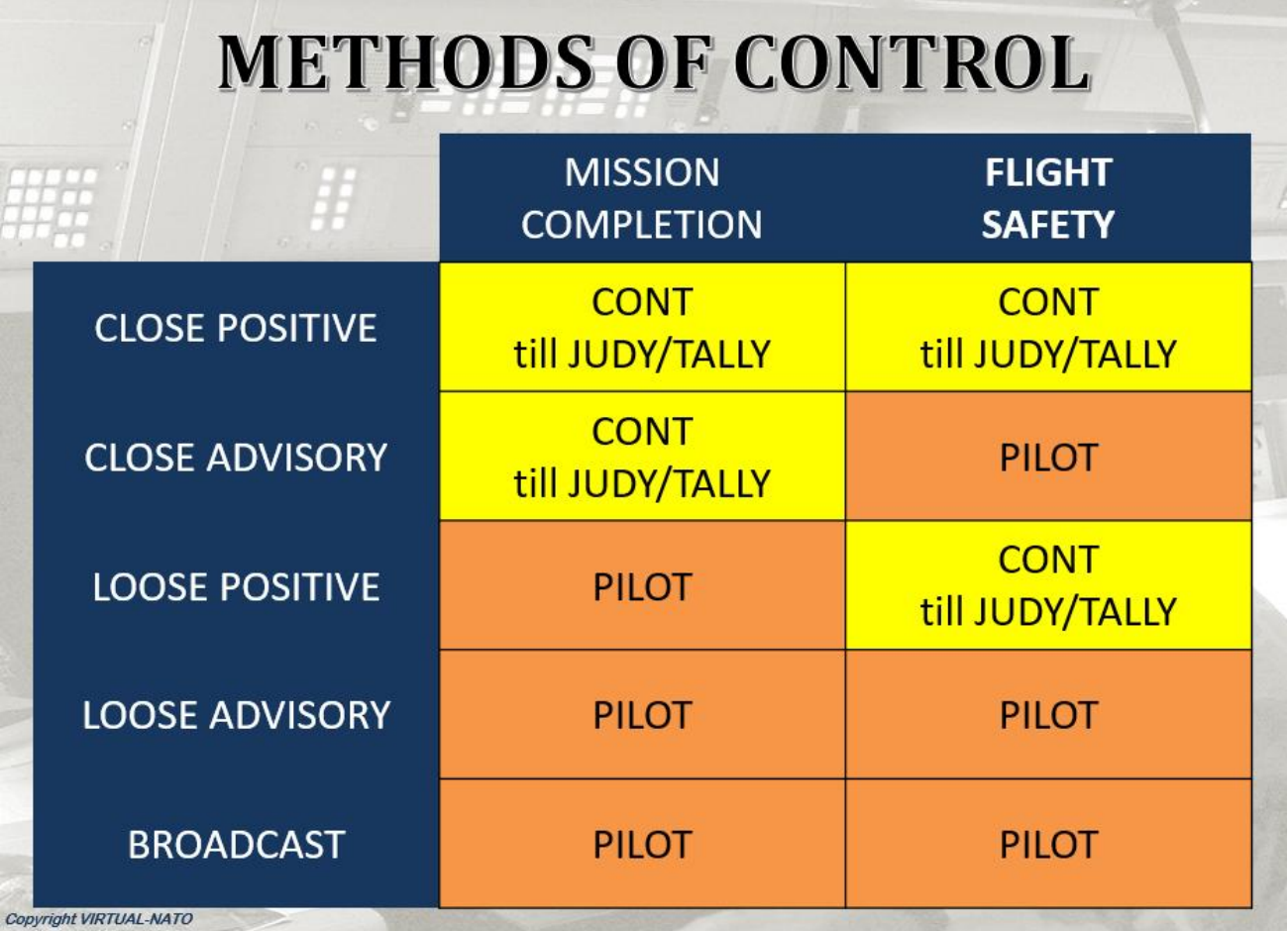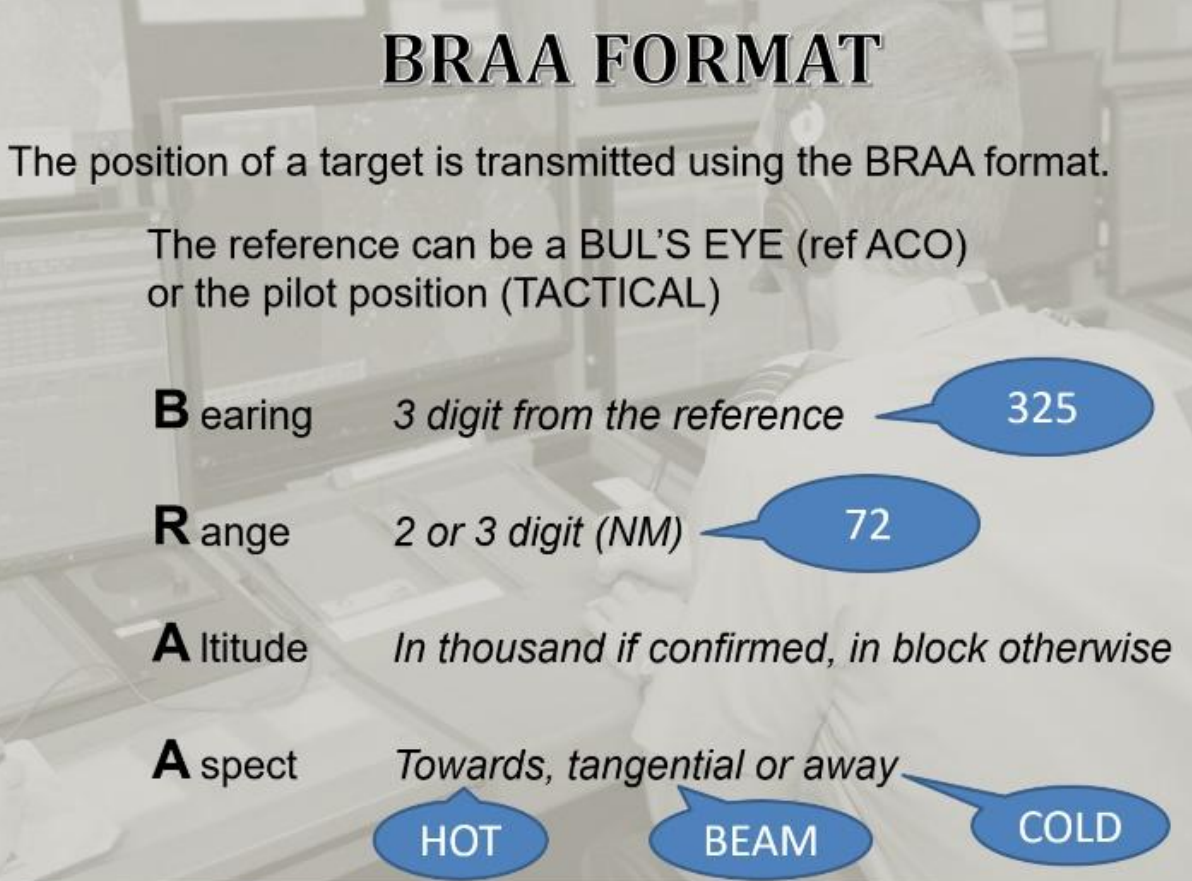Military Enroute
The Following Page have been kindly provided by Virtual NATO.
Reference Documentation
Charts and Maps for German Military airfield and Airspace can be found on the Mil AIP (www.milais.org).
Formation Flights
Formation flights shall be controlled/cleared as a single aircraft unless the formation leader requests otherwise.
Radio communication flow is strictly between the formation leader and the controller. The controller should expect a radio roll call from all wingmen before being contacted by the leader (i.e: "NATO11 check... 12... 13... 14. SUNRISE, NATO11").
Should a call be addressed to a specific wingman, the controller must use the aircraft callsign including the sequence number. (i.e: "NATO13 SUNRISE squawk normal").
The responsibility for separation between elements of a formation flight rests with the pilots in the formation: Military Authority Assumes Responsibility for Separation of Aircraft (MARSA).
Enroute
Radar Control
When the controller has positively identified the aircraft (Position, heading, altitude, Squawk), he will take the responsibility of the its safety with this procedure:
[ (aircraft callsign) [RADAR] IDENTIFIED, [(number) DEGREES (number) MILES (Ref Point)], [SQUAWK (number) ],
Instructions or information if the aircraft was flying at a different type previously (i.e. climbing from low level)
[ YOU ARE NOW IN IFR (or OAT INDIA or TANGO)]
Methods of Control
The method of control is the concatenation of 2 criteria:
- The type of control which determines the responsibility for the mission completion.
- The level of control which determines the responsibility for flight safety.
Types of control
There are 3 different types of control, which can determine how the mission is conducted:
Close Control
In a close control sortie, controllers are responsible for mission completion. During Enroute sortie in OAT IFR, pilots must follow and execute all controller’ commands.
Loose Control
In a loose control sortie, the controller transmits only information to the pilot, with no commands. Pilot is responsible for the mission completion. Broadcast Control. The controller will transmit general information and activity within the designated area in the form of
Broadcast
The format of the broadcast will depend on the tactical situation. Pilot is responsible for the mission completion.
Levels of control
There are 2 different levels of control, which determine the level of responsibility for safety.
Positive Control
Under Positive control, the controller is responsible for keeping the safety separation:
- Between all aircraft he is controlling (except within formations),
- From strangers
Advisory Control
All Flight Safety and separation actions are the responsibility of the pilot.
Change flight type or control method inflight
Change Flight type.
When the mission requires, aircraft or formation may request to change the flight type. For example, a Reconnaissance (RECCE) mission will start the mission in High Altitude under OAT IFR and descend later in low level to approach the target before climbing again to high altitude for recovery. Changes must be clearly stated on the frequency to transfer the responsibility to pilot/controller.
Pilot Request:
[ REQUEST TO CHANGE FOR OAT TANGO [or VICTOR or INDIA] [VMC (or IMC)] [(significant point or area) FROM (level) TO (level)] [TO (time or significant point)] ]
Controller Reply:
[ YOU ARE NOW IN OAT TANGO [or VICTOR or INDIA] [SQUAWK (code)]
[REPORT END OF WORK (or significant report point) if required ]
If end of work
Pilot message:
[ END OF OAT TANGO, REQUEST TO RESUME (or TO CHANGE) OAT VICTOR [or INDIA] ]
Controller reply:
[ YOU ARE NOW IN OAT VICTOR (or INDIA) ]
Every change of method of control must be clearly stated on the frequency.
Pilot request:
[ REQUEST CLOSE (or LOOSE) POSITIVE (or ADVISORY) CONTROL ]
Controller reply:
[ CONTINUE IN OAT VICTOR, BROADCAST (or ADVISORY) CONTROL ]
Mixed flight OAT/GAT/OAT
A "mixed" flight is a flight with alternating phases of flight conducted in General Air Traffic (GAT) and Military Air Traffic (OAT).
For operational reasons, the mixed flight plan may be used in the following situations:
- AEW aircraft proceeding to the orbit area in GAT and switching OAT during the On Station (or vice versa)
- AR tanker proceeding to his Air Refueling area
- Aircraft departing OAT and going abroad or coming back from abroad
The mixed flight plan is treated twice, one for the GAT part and the other for the OAT part. It is crucial to carry out the task with the utmost care, as this could lead to errors during the flight plan's computer processing and result in its rejection.
Mixed flight is specified in field 18 under RMK/ MIXED GAT OAT or MIXED OAT GAT as applicable.
The change of flight rule shall occur over the Transfer Point : Fix in GAT or WP in OAT. Controllers should proceed to the frequency change 1 minute before the aircraft reaches the XFER point at the latest.
Special Activities
QRA (Quick Reaction Alert)
In accordance with SOP PPM and the LOA between vNATO and VATGER, the Enroute controller online can either scramble the QRA (if any available or planned) or divert an airborne vNATO asset to intercept an aircraft that is not respecting the VATSIM rules (no FPL, no radio contact etc...).
The vNATO pilot shall mention “AIRBORNE ALERT CAPABLE” if he is qualified QRA. Squawk assigned to QRA are:
- QRA A7400
If the controller is GCI qualified, he is allowed to provide CLOSE POSITIVE control to perform the interception at the fastest and best conditions.
If the controller is not GCI qualified, he can only provide LOOSE POSITIVE control to perform the interception.
He will provide the fighter pilot with the target position using ground geographical reference or the fighter/target relative position (bearing & range) along with available details (altitude, aspect). The success of the interception relies only on the fighter pilot
Control sequence:
Take-over after Scrambled mission:
Pilot: [ SUNRISE, NATO XRAY ]
Controler: [ NATO XRAY, SUNRISE, RADAR CONTACT, LOOSE POSITIVE, TURN RIGHT (or LEFT) HEADING (number), CLIMB [FLIGHT] LEVEL (number) ]
If no target assigned:
Controler: [ YOU ARE ON AIRBORNE ALERT, HOLDING POINT AS FRAGGED ]
If (or when) an target is assigned:
Controler: [ YOUR TASK IS QRA INTERCEPT (or AIR POLICING) ON A TARGET CLASSIFIED (classification), BRAA (number), PRESUMED FORCE (number), SQUAWKING (number), CHECK WEAPONS SAFE ]
Target amplifying information:
[ TARGET CLASSIFIED (classification) BRAA (number), STRENGTH (number), SQUAWKING (number) ]
Work in reserved airspace
Aircraft intending to perform air maneuvers will proceed to a booked area (TRA, TSA, Restricted or Dangerous). They may join the area in GAT IFR, OAT IFR or VFR. When reaching the area, they change type to OAT T (Tactical).
For mor information visit --> Restricted Areas
Airborne Early Warning & Electronic Warefare
The control of EW or AEW assets is limited to providing situational awareness outside the working area assigned to the assets. Once they are ON STATION on their assigned orbit, they are prioritized in their airspace (booked area and altitude block).
AEW / EW Control procedure:
- Ask the pilot to confirm the working Level [ REPORT ORBIT (FLIGHT) LEVEL ]
- Clear the aircraft to climb/descent at Orbit level [ CLIMB (or DESCEND) ORBIT LEVEL (number) ]
- Ask the pilot to advise when On Station [ REPORT ON STATION ]
- Assign squawk [SQUAWK A7423 or 24]
- Ask the pilot to advise when Off Station [ REPORT OFF STATION ]
Note: EW and AEW assets transmit high power microwaves, therefore it is forbidden to allow any aircraft to fly close unless the equipment is switched off.
Aircraft Captain must be requested the authorization for any kind of interception.
Supersonic Flight
Supersonic speed flights over German territory are only allowed if at least one of the following conditions is met:
- Within the Supersonic Area over the north sea.
- Above FL360.


